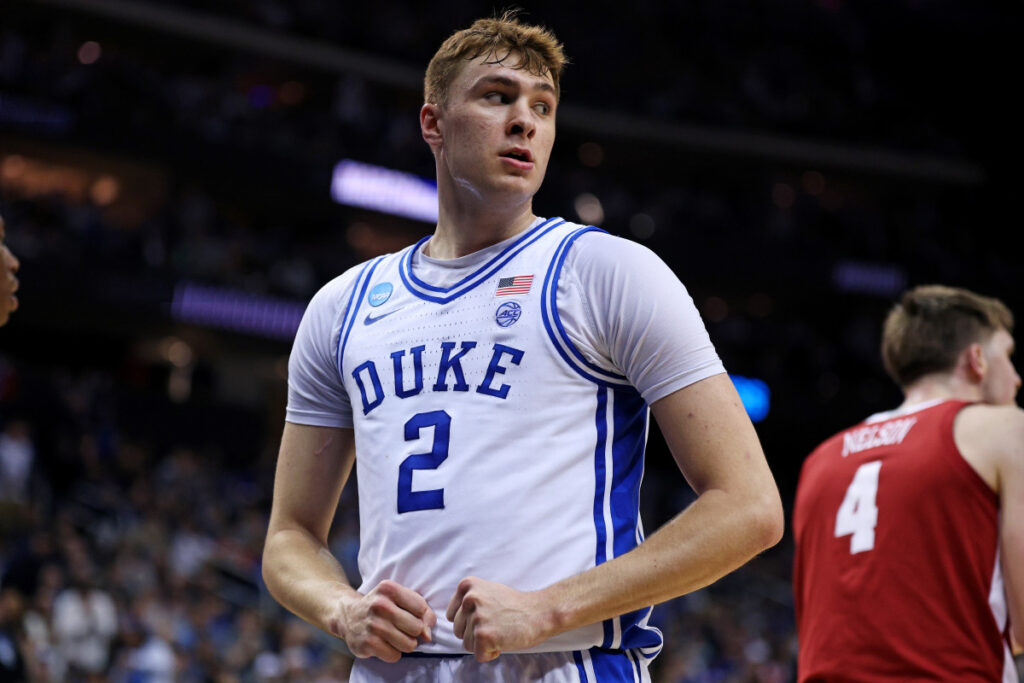For the past 10-15 years, NCAA men’s college basketball has been dominated by elite first-year talents. The likes of Anthony Davis, Zion Williamson and Jayson Tatum have catapulted to NBA stardom after only one year in college. However, recently implemented name, image and likeness (NIL) regulations and the free-for-all transfer portal have changed the sport. The 2025 men’s Final Four perfectly illustrated how experience matters more than NBA draft lottery talent in college basketball.
Over the course of the 2024-25 NCAA men’s college basketball season, the epicenter of the sport revolved around Duke, largely because of the presence of Cooper Flagg, the 2025 Naismith Player of the Year and soon-to-be No. 1 NBA draft pick.
The Blue Devils, led by Flagg and fellow highly-touted first-years Kon Knueppel and Khaman Maluach, faced little resistance until their Saturday evening Final Four matchup against the Houston Cougars. The winner would move on to play the victor of Florida vs Auburn in the national championship game on Monday night.
While Duke worked the transfer portal to construct a roster centered around its three young stars, the other three teams comprised primarily upperclassmen who have been through the wear and tear of college basketball and know what it takes to win at this level.
In addition, Duke finished the regular season with only three losses, dominating almost every game against Atlantic Coast Conference (ACC) opponents. On the other hand, Florida and Auburn were pushed to their limits competing in a Southeastern Conference represented by a record-breaking 14 schools in the NCAA Tournament. Likewise, Houston faced numerous challenges against the likes of Kansas, Arizona and Texas Tech in the Big 12.
Thus, it was hardly surprising when Duke’s youngsters suffered a final minute meltdown against Houston’s high-pressure defense, choking the lead and losing a game they had been in control of pretty much since tip-off. Flagg, who did not play like a typical first-year this season, committed a foul fighting for an offensive rebound and then missed a turn-around jumper at the buzzer, which would have sent his team to the title game rather than coach Kelvin Sampson’s group.
“I hear what people say. ‘Duke this. Duke that.’ Duke’s great. Jon Scheyer is awesome,” a fired up Sampson told CBS reporter Tracy Wolfson after the game. “But don’t sleep on Houston. We weren’t 34-4 playing in the Toy Poodle League. We were 19-1 in the Big 12. Playing in the Big 12 helped us.”
The 2025 title game between Houston and Florida marked the first time in the modern era to feature no freshman on the court, a stark contrast to what college basketball fans are accustomed to seeing in this one-and-done era. As a result, it reinforced just how important player retention and development is today, especially given the chaotic transfer portal and high school recruiting scenes.
Both the Cougars’ and the Gators’ rosters included multiple players who began their collegiate careers at other schools. Houston’s leading scorer LJ Cryer spent his first three seasons at Baylor, while the Gators’ trio of senior guards Walter Clayton, Will Richard and Alijah Martin all transferred to Florida to get more exposure and test their abilities at a higher level.
In Martin’s case, he moved a few hours north after spending the last four years at Florida Atlantic University. He played a major role in the school’s Cinderella journey to the Final Four in 2023, deciding to transfer once his coach Dusty May left to take the same position at the University of Michigan.
The trend of players transferring from smaller schools to Power Four programs has surged since the transfer portal opened. That explains why this past month’s NCAA Tournament had fewer upsets and crazy moments than previous editions because the typical March underdog teams are no-longer able to prevent their most talented players from leaving for bigger opportunities.
Every year, the men’s NCAA Tournament has a different outcome and results in multiple storylines, making it one of the most unpredictable events in sports. Moving forward, it seems that the best bet for teams who want to reach the Final Four is to lean heavily on experience with a smattering of youth.
After all, the talent emerging out of high school basketball is only getting better and there will always be a path for teams heavily reliant on one-and-done types to succeed in college basketball.
Nevertheless, as the Final Four showed, the teams that perform the best are led by experienced veterans with a stable culture imposed by head coaches who know how to work the portal and get the best out of their athletes.


